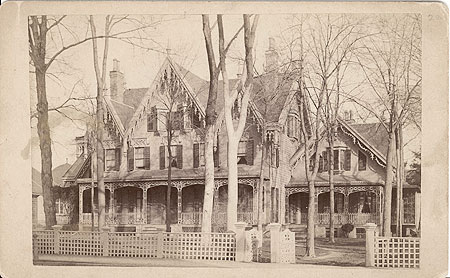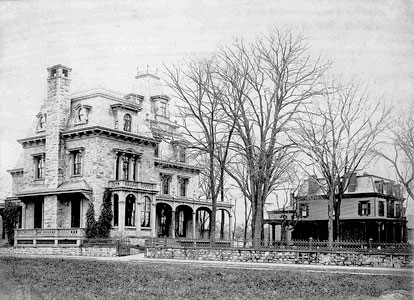 The Stamford Historical Society Presents
The Stamford Historical Society Presents
GRACIOUS LIVING IN STAMFORD
Late 19th and Early 20th Centuries
Photos and Objects from Our Collection
Downtown Stamford
Home of William W. Gillespie, 65 Washington Avenue
Inset: William W. Gillespie, c. 1892
William Gillespie was president of Gillespie Lumber Co. at Waterside, a business he started originally as White, Gillespie & Thayer, which on Mr. White's withdrawal became Gillespie & Thayer. Finally, in 1889, he organized a joint stock company, Gillespie Lumber Co. He was also connected with the Waterside Mills, on the same premises as his lumber business. He successfully obtained government aid for the improvement of Stamford Harbor.
Earlier, he had made his way up in the Stamford Advocate, but in 1883 he retired and sold the business to his brothers, E.T.W. & R.H. Gillespie.
Mr. Gillespie was also a writer, speaker and lecturer upon a wide variety of topics, especially in the field of applied science.
The Gothic Hall, c. 1892
Staircase, May 9, 1890

The Gothic Hall was situated on Broad Street at the corner of Bedford Street, later the site of the Ferguson Library.
The first Gothic architecture introduced into Stamford, it was erected in 1830 by the George E. Waring. The original property extended along Bedford Street to Spring Street and contained, from 1836 to 1841, his foundry, later called the Stamford Foundry Company. For a period of time, beginning 1869, it was the home of the Catherine Aiken School, which later moved to Dolsen Place.
For many years, Gothic Hall was the home of Mr. John A. Brown, President of The Stamford Trust Co.
Guide to Nature Magazine (April 1910) called it “quite a fine mansion, with its imposing gateway, and high posts, and the broad hall through the center of the house, with its handsome winding staircase.”
Home of Mr. Charles E. Smith (1809-1907)
19 Washington Ave., next to St. Andrews Church
“Greyrock,” Home of Mrs. George A. Hoyt
Main Street at Greyrock Place. November 22, 1889

Built in the 1860s. This was later the East side of Greyrock Place going as far as Broad Street.
George Hoyt lived there until his death in 1887. Mr. Hoyt developed all of Stamford south of the rail road tracks. (Hoytville).
The house to the right was the William Skiddy House, just west of the Episcopal Church.
Home of Mrs. Edward G. Smith, Richmond Hill
April 12, 1890.
Front View, Side and Rear View.

